You get on a Teams call with the sales and marketing team.
Share about the newly launched product features. Record the call and share the recorded calls with everyone on the call after the meeting. That's it.
Is that how you transfer knowledge to different departments?
If so, let us break it to you: you'll be disappointed.
Why? Because most departments forget the knowledge you share in the meeting. And the remaining who remember what was discussed in the meeting? They miss out on the important details.
This knowledge transfer system is broken.
But hey, you're not alone in this. We'll help you get into the details: what is knowledge transfer, what it's not and how to create your knowledge transfer plan.
Let's dive in.

What is Knowledge Transfer?
Knowledge transfer is the method of passing on information, expertise, or skills from one department, team, company, or individual to another.
Mainly, a specific team member acquires the niche or specialized information (or skill). When collaborating with other team members, it becomes difficult for them to understand and implement the information because only one person acquires complete information on the topic.
That's why knowledge transfer aims to share and retain critical knowledge within the organization.
For example, your product team has recently launched a new product. The product is currently in the beta version but needs to be shared with the marketing team before it can be promoted. However, the only people with product knowledge are the product manager and the engineering team members. So the product manager can give the product demo to the entire marketing team and record it.
You see what happened here? The product manager transferred their knowledge about the product to the entire team.
What knowledge transfer is not?
Knowledge transfer is not about circulating information and training your team members.
It involves more than just sharing facts; it focuses on utilizing team members’ skills to apply the information.
Also, knowledge transfer does not equate to simply documenting the knowledge. Yes, documentation is a part of knowledge transfer.
But, it requires true understanding and practical application, especially tacit knowledge, which is hard to convey.
Benefits of Knowledge Management
But why exactly do you need to transfer and manage your knowledge?
- Consistency and efficiency: When the knowledge is transferred to other team members and documented, it provides a framework for execution. This way, every team member knows the exact action steps to accomplish the task—leaving no space for errors.
- Employee empowerment and engagement: Employees can quickly access the knowledge base without the back and forth of reaching out to another team member or their manager and getting the work done without any blockers. This boosts their productivity.
- Reduced operational redundancies: When you have all the processes documented, it reduces the need for employees to repeat tasks that have already been solved.
Identifying Critical Knowledge
Before you map out a knowledge transfer plan, know the different types of knowledge and their purpose:
Tacit Knowledge
Tacit knowledge is intangible and intuitive knowledge that relies on observation, practice, personal experience, and social interactions.
However, this type of knowledge is difficult to articulate and share. Why? Because the information contained is thought-based.
For example, a support agent’s ability to diagnose the issue by listening and understanding customer complaints.
Explicit Knowledge
Explicit knowledge is structured and easily transferable information—mainly formal and documented in the form of books, courses, PDFs, whitepapers, and so on.
Within an organization, explicit knowledge appears through FAQs, instructions, and data reports.
For example, a SaaS company lists step-by-step instructions on how to use the software in its user manual, as well as relevant screenshots and troubleshooting steps.
The Knowledge Transfer Process
The process of transferring knowledge is not butter smooth. It is broken down into 5 different steps: defining your needs, identifying and collecting knowledge, capturing and transferring it, and finally evaluating it.
Let's understand the entire process in detail.
Step 1: Define your needs
First, identify what type of knowledge you need to gather and from whom. Here are a few questions to get you started:
- What are the main risks for your business?
- What business areas are the most impacted by these risks?
- Who are your go-to people or SMEs in these areas?
- What tasks do they carry out that no one else does
- What other activities are these people relied upon to do?
- Who needs to be involved to collect the knowledge?
Step 2: Identify and collect knowledge
At this step, you need to understand what knowledge to prioritize. So, ask yourself:
- What information is the most needed to keep your business running smoothly?
- How many people possess this knowledge
- How often is this knowledge required
💡Pro tip: Give a score to each question, add up the total, and then assign a high, medium, or low ranking to determine your priorities.
Now that you know which knowledge to prioritize, it’s time to collect it. But for that, first review what *exactly* your company is doing.
- Are you brainstorming ideas?
- Are you learning new skills?
- Are you finding a solution to a problem (while working on the project)?
- Are you working on new projects to acquire new knowledge?
Your goal here is not to transfer knowledge but to build a database of ideas in your company so everyone can share ideas and expertise. If you haven’t been doing this in your company yet, do this:
- Bring up challenges the company has been struggling with and seek solutions
- Document these challenges and the relevant solutions
- Discuss the different solutions with your internal team
- Encourage cross-collaboration between different departments
Once you see that your company has been integrating a knowledge sharing culture where teams are sharing ideas, make a list of SMEs you have identified and capture their knowledge.
- Critical tasks they look at and their importance level
- When and how each task or activity is carried out
- Is there anything that needs to be done before or after the task
- Who is impacted if the task is accomplished or not accomplished?
- Why is this task important?
- What resources are required to carry it out?
- What technical documentation is needed
- What are the limitations of the current process
- How could the current process be improved
- What are the risks that could prevent project completion
Step 3: Capture and store knowledge
Since you want to capture tacit and explicit knowledge, the methods to capture each knowledge differ.
Tacit knowledge
- Interviews: One-on-one interviews with subject matter experts.
- Work shadowing:
- Mentorship: One-on-one guidance and support provided by more experienced employees.
- Communities of practice (CoPs): Groups of people who share a set of problems or interests about a topic and deepen their knowledge by interacting continuously.
Explicit knowledge
- Documentation: Manuals, guides, and standard operating procedures (SOPs) that capture important information.
- Surveys: List of questions or questionnaires sent to employees using a form to understand employees’ knowledge gaps and get expert insights.
- Employee forums: Online forums where employees can ask questions and share their insights.
- Knowledge repository: Centralized hub to document, organize, and provide access to organizational knowledge.
While the methods involved in capturing tacit and explicit knowledge are helpful, at one point, you need to document this knowledge —especially when transferring the knowledge to your internal teams and other departments.
Let's say you're a sales manager who has been coaching a new sales rep on tackling sales objections and taking sales calls confidently. While the rep is learning from you on how to tackle the different scenarios of customer objections, he might not remember every scenario you have been sharing with him. That's when you must document the different scenarios in the knowledge repository.
When stuck during the objection-handling stage, this will help the new sales rep and your entire sales team.
So, the next step? Capturing tacit knowledge using a knowledge management system.
But that's where most companies make the big mistake. Google Drive becomes their bestie.
Here's the thing: just like every department has a hierarchy, your knowledge management system needs a hierarchy too. It can't be achieved by throwing all the information into a Google Drive.
You need an appropriate knowledge system that helps you capture, organize, and share this information with other departments.
So, what exactly should your knowledge capturing system must include:
- Visuals and videos
- Reports
- Document libraries
- Knowledge portal
- CRM system
- A dedicated team
You can have all these components in your knowledge base with Slite.
When you create department-specific channels within Slite, you have multiple documents and folders inside each channel.

You can organize the information inside each document with various formatting options—bullet lists, checklists, sketches, and files. Furthermore, you can embed loom videos, content from social media platforms like X, meeting recordings, flowcharts, explainable visuals, interactive survey forms, and scheduling links to conduct meetings with your team.
Also read: Knowledge base vs chatbot: Which one does your team actually need?
Step 4: Transfer and share knowledge
There's a thin line between capturing and transferring knowledge.
Capturing knowledge is converting tacit knowledge into explicit knowledge so that the information is documented and available for future use.
However, knowledge transfer focuses on distributing the captured knowledge to stakeholders across different teams and departments and enabling them to implement it.
Now, before the knowledge transfer happens, ask yourself these questions:
- What is the skill or knowledge being transferred?
- What time and resources are available?
- How many people are involved, and to whom do you need to transfer the knowledge?
- What are the preferred channels of communication involved?
- What security and privacy levels apply to this knowledge?
Since you have already captured the tacit and explicit knowledge, it's time to design a sharing mechanism to transfer and create the knowledge management plan.
The main components include:
- A clearly outlined process document
- Technology such as a document management system, wiki software, or knowledge management system
- Internal communication software
- A dedicated person to circulate knowledge to relevant departments
Let's stick to the sales rep scenario we talked about previously. The sales manager notices a pattern in his sales team: the sales team is finding it hard to address customer objections, leading them to lose deals.
So, the sales manager decided to share the knowledge about sales objections with the entire sales team (and not just the newbie sales rep).
He can use knowledge management tools like Slite to transfer the knowledge with his sales team.
The sales manager can invite each rep from his sales team to Slite. The reps can view the document containing loom videos with multiple sales objections, tables with details on the type of objection, when to use them, and why, and additional links the team can reference to improve their skills.
All of it is organized in one place.
If a content writer reaches out to the sales team to ask them questions about customers and their pain points when writing their new blog post, the sales team can add them to their sales objections document and give them access to view the document.
You see? There is no friction in sharing the information and no delay in sharing the information with other departments. It saved both departments from chaos.
Step 5: Evaluate the knowledge transfer plan
What does a successful knowledge transfer plan look like to you? To do this, you must first identify KPIs relevant to your goals. They include:
- Increase in productivity
- Increase in employee engagement levels
- Reduced onboarding time for new hires
Evaluate how well the team has implemented the transferred knowledge. For instance, a sales manager might use an increased close rate after the knowledge transfer to indicate a successful knowledge transfer.
If you feel the knowledge transfer hasn't been implemented as it should have been, review the knowledge transfer plan and adjust it.
Also read: How Atomic Cartoons transformed knowledge sharing for 1,000+ creatives with Slite
Overcoming barriers to knowledge transfer
While you may be doing your best, you could be struggling in doing so because of two barriers. Let's decode what these two barriers are and how you can tackle them.
Challenge 1: Inadequate documentation
Poor documentation = project delays + compromised quality + broken communication
What does this really mean? When you have poorly written documentation, your team faces execution errors and misinterpretations, leading to project delays and misalignment within the team.
The solution?
Establish clear guidelines and templates for documentation--for consistency across teams.
Implement periodic reviews to make sure the documentation is accurate and up-to-date with relevant information.
Use a knowledge management system like Slite to streamline your documentation and make it accessible to your team.
However, even the best documentation becomes useless if teams can't find what they need when they need it. Super transforms knowledge transfer by connecting your Slite documentation with Linear tickets, Slack conversations, and 20+ other business tools into one intelligent search interface. Instead of asking "Where did we document the sales objection handling process?" team members can ask "Show me all guidance for handling pricing objections" and get comprehensive answers from training docs, actual sales conversations, and CRM data with source citations.

This cross-tool intelligence is especially valuable for knowledge transfer scenarios where information spans multiple systems. When transferring product knowledge to marketing teams, Super can surface not just the documentation but also related GitHub commits, customer feedback from support tickets, and usage analytics—providing complete context for better knowledge application. Teams save an average of 4 hours per person per week while ensuring transferred knowledge gets discovered and used rather than forgotten in document repositories.
Built by the team behind Slite, Super integrates seamlessly through Chrome extension, Slack bot, and web app access. Ready to ensure your knowledge transfer efforts actually reach the teams that need them? Book a demo to see how enterprise AI search enhances organizational knowledge flow.
Challenge 2: Cultural and social challenges
Employees from different backgrounds may have different communication styles, leading to misunderstandings and misinterpretations when understanding the information.
Besides, a lack of trust and siloed departments are two other big challenges that organizations experience.
When team members don't trust each other, they may withhold information out of fear of competition. This is a big obstruction in collaboration. In addition, if companies don't have a culture of cross-collaboration, the knowledge stays within the department, leading to limited access to other departments that may benefit from those insights.
For example, the content team can promote the product better only if they have product insights from the product team—everything from the features to different use cases.
If the product team withholds the product knowledge and doesn't share it with the content team, it will be difficult for the content team to write product-led content.
So, what's the solution?
- Foster knowledge sharing culture: Encourage different departments to unite, share ideas, discuss challenges, and seek solutions.
- Reward knowledge sharing: Public acknowledgment in meetings or incentives for employees actively participating in knowledge-sharing activity.
- Build trust among team members: Make team building activities and mentorship programs part of your organization to strengthen your team’s bonding, reduce fears, and encourage open communication.
- Provide training on cultural sensitivity: Integrate training programs that educate employees about diverse communication styles and cultural norms to simplify communication and make collaboration easier.
Also read: Improve knowledge sharing at work: 8 simple ways that actually work
How to use Slite to improve knowledge transfer in your organization
Step 1: Set up your Slite workspace
Organize your Slite workspace by creating department-specific channels. Each channel can be dedicated to a different department. This will make it easier for team members to find and contribute knowledge.
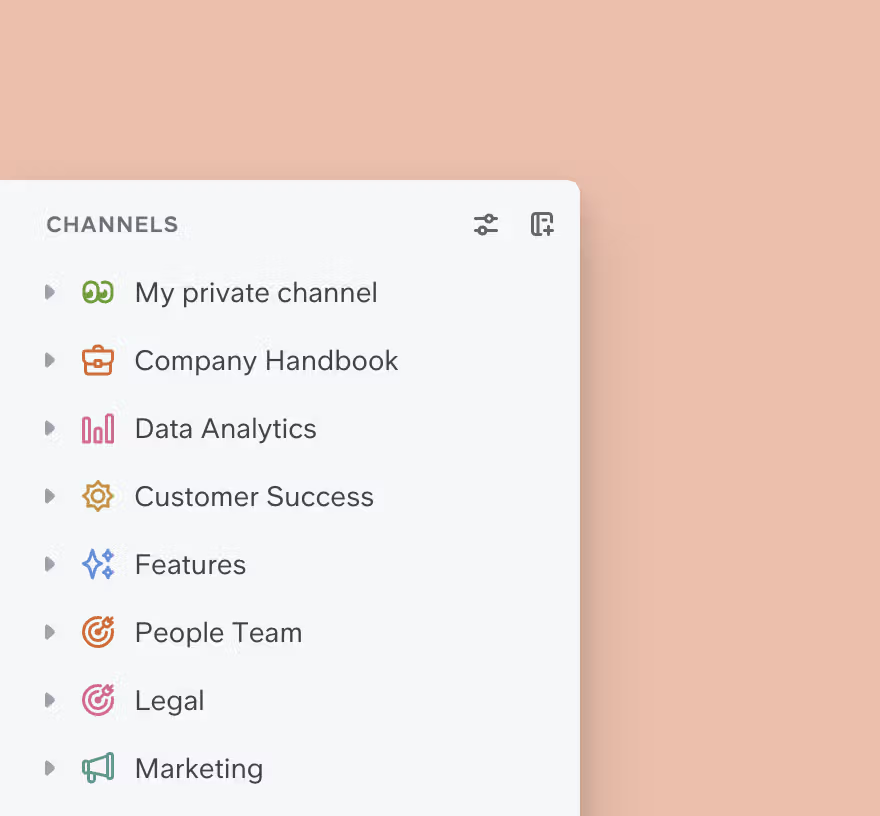
You can keep these channels public to your internal teams. You get two permissions to choose from: writer and reader.
- Writer: Edit the document
- Reader: Only read the document
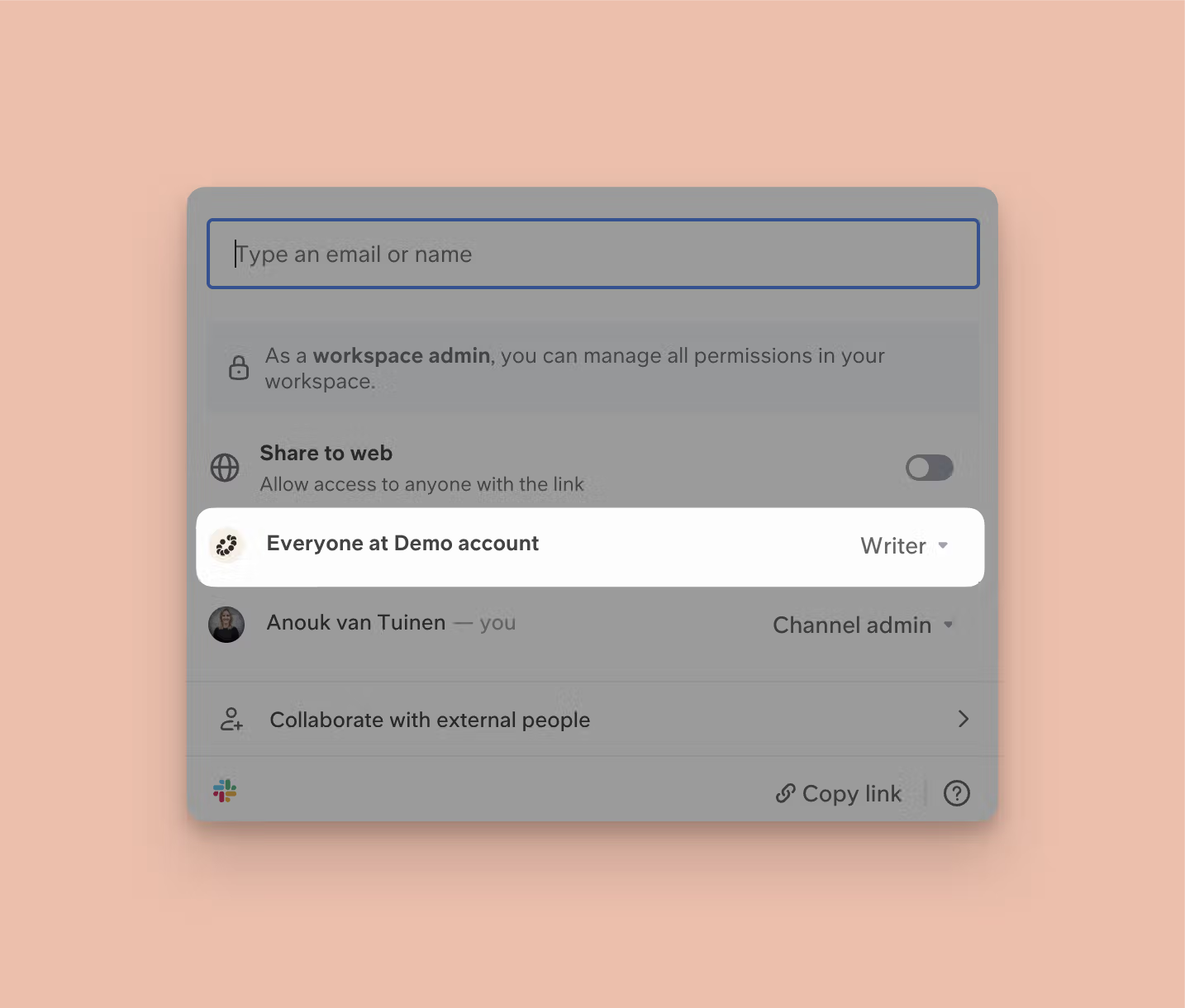
Step 2: Document and centralize your knowledge
Once you have identified the critical knowledge areas that need to be documented, such as standard operating procedures (SOPs), project workflows, company policies, and frequently asked questions (FAQs).
Use relevant templates from Slite’s template library. This ensures consistency and completeness in the documentation process.
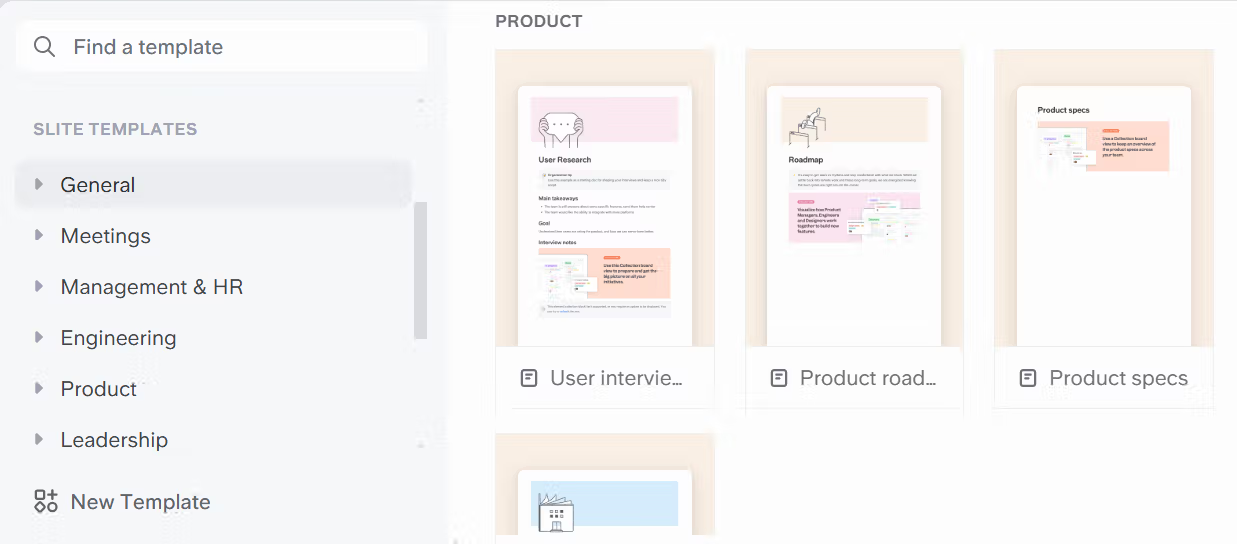
Sidenote: If you want to upload your documents directly from Google Docs and access the Slite workspace from Slack, you can add the relevant integrations.
Step 3: Keep your documentation up-to-date
You’ll find the option ‘Verify the doc’ at the top of your document. Tap on it, and it will give you different options.
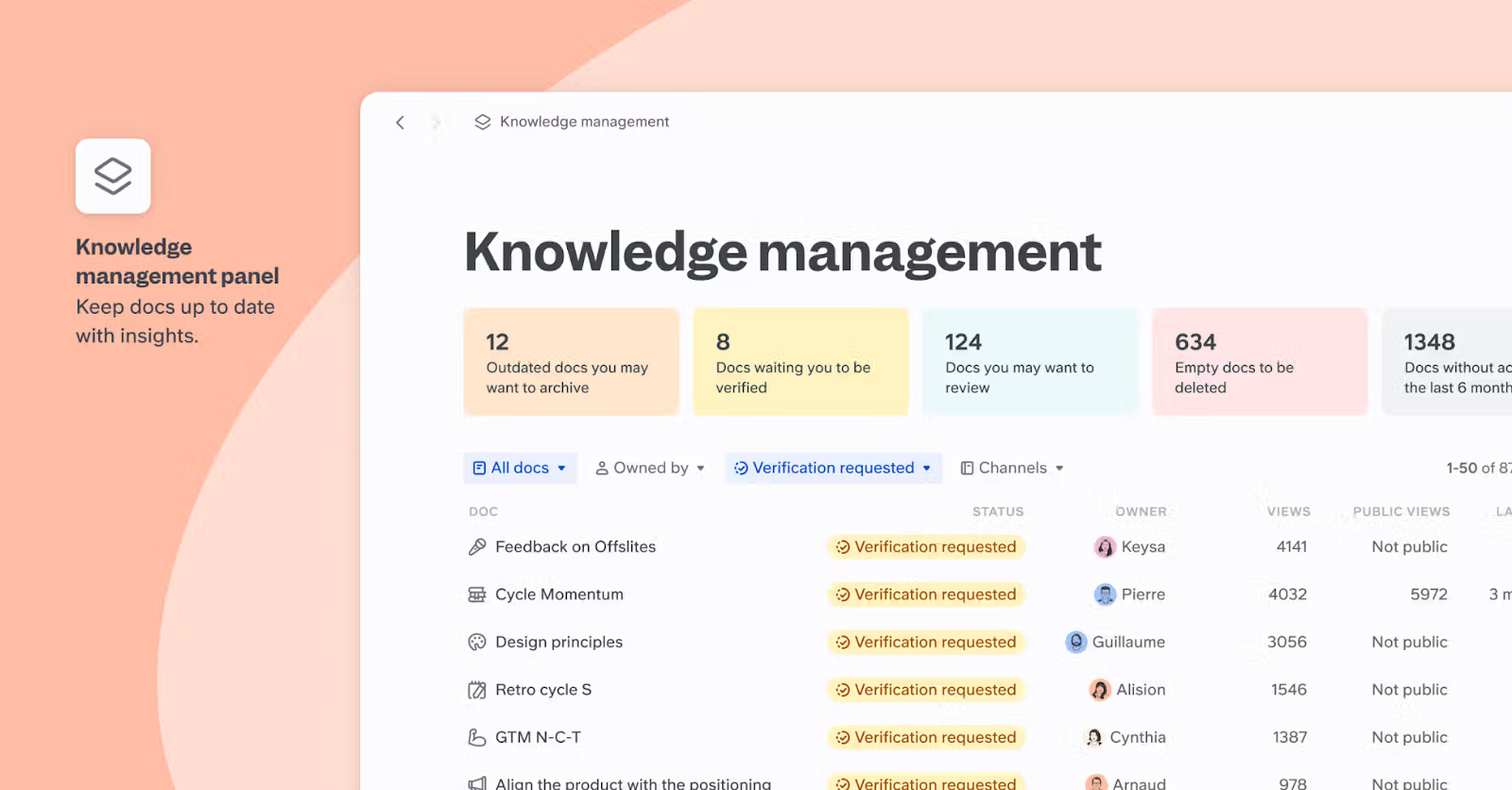
- Verify the doc so that team members know the information is accurate and verified.
- Flag as outdated to notify the team members that the information is outdated. You can also add a note explaining what is outdated.
- Request verification to send a request to the SME to verify the document with a note on what information needs to be reviewed.
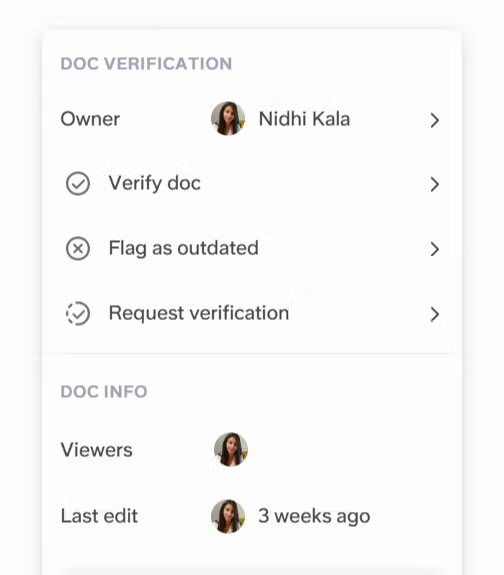
You see? How streamlined the documentation process. Want to know how you can improve your knowledge transfer with Slite? Get a 14-day free trial and try it for yourself.

